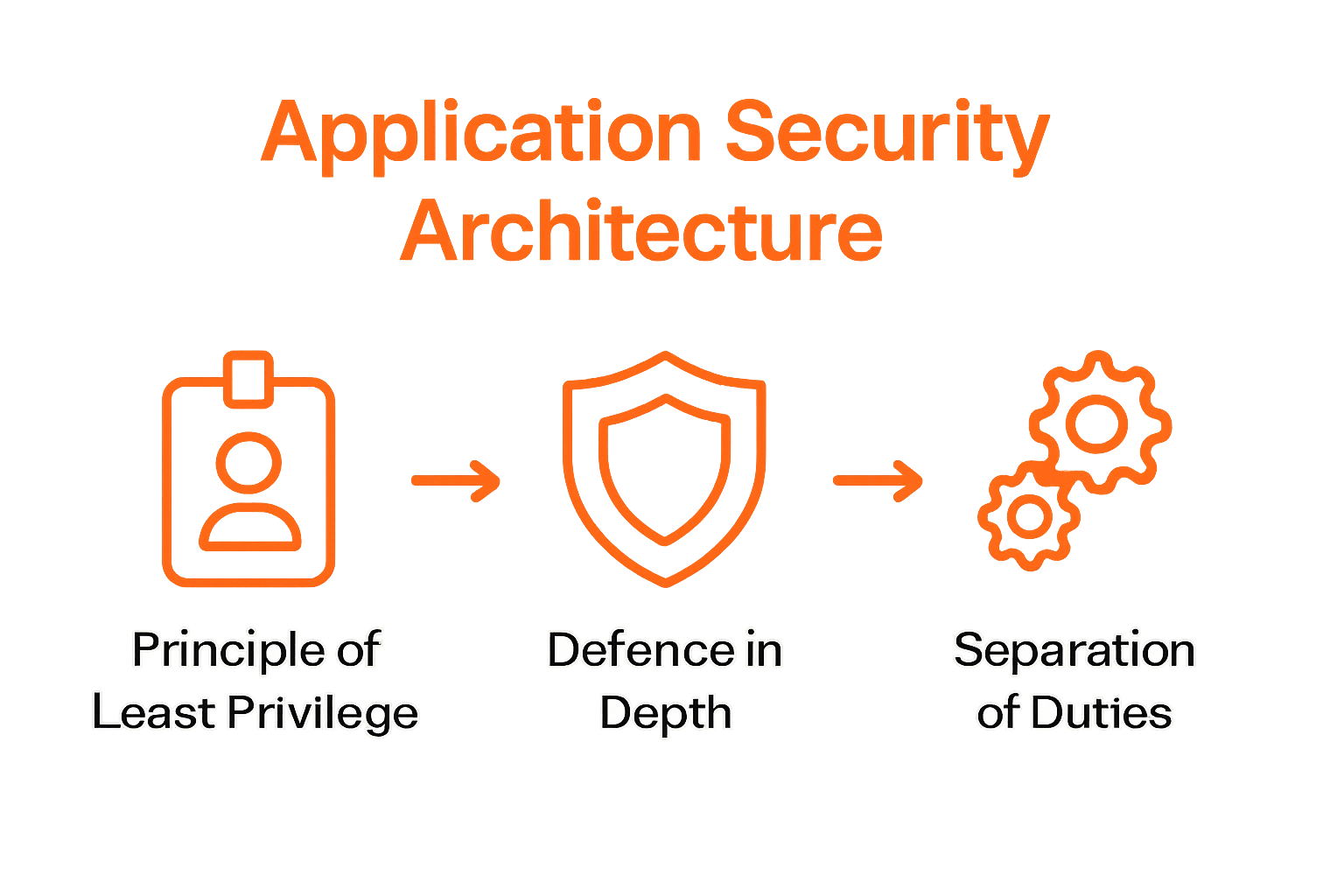Understanding Business Application Security for Companies
Business application security shapes the way companies keep their systems safe. With the average cost of a data breach now sitting at over R70 million for South African businesses, ignoring application security is no longer an option. Most people think you can protect your business just by installing antivirus software or firewalls. Turns out the real difference comes from protecting the actual applications your business relies on every day and building a security culture that evolves as fast as the threats do.
Table of Contents
- Defining Business Application Security: What Is It?
- The Importance Of Business Application Security In Today’s Environment
- Key Concepts And Principles Of Business Application Security
- How Business Application Security Mitigates Risks And Threats
- Real-World Applications And Case Studies Of Business Application Security
Quick Summary
| Takeaway | Explanation |
|---|---|
| Prioritize code-level protection | Address potential software vulnerabilities during development to enhance security. |
| Implement robust access controls | Use strong authentication methods to regulate who can access applications effectively. |
| Adopt continuous monitoring | Employ real-time threat detection to quickly identify and neutralize potential cybersecurity incidents. |
| Understand the principle of least privilege | Limit user access to only what is necessary for their roles to reduce potential attack vectors. |
| Create flexible security frameworks | Develop adaptive security strategies that evolve with emerging threats through consistent risk assessment. |
Defining Business Application Security: What Is It?
Business application security represents a comprehensive approach to protecting software applications used within an organization from potential cybersecurity threats and vulnerabilities. Unlike generic security measures, this specialized strategy focuses specifically on safeguarding the digital tools and platforms that power business operations.
Core Components of Business Application Security
At its foundation, business application security encompasses multiple critical elements designed to shield software from unauthorized access, data breaches, and malicious attacks. According to the National Institute of Standards and Technology (NIST), this approach involves strategic implementation of software, hardware, and procedural methods that protect applications throughout their entire lifecycle.
Key components of business application security include:
- Code-level protection: Identifying and addressing potential vulnerabilities during software development
- Network security integration: Ensuring applications interact safely within broader network infrastructures
- Access control mechanisms: Implementing robust authentication and authorization protocols
Risk Mitigation and Strategic Importance
Business application security goes beyond simple defensive tactics. It represents a proactive strategy that helps organizations anticipate, identify, and neutralize potential cybersecurity risks before they can cause significant damage. By integrating comprehensive security protocols, businesses can protect sensitive data, maintain operational continuity, and preserve their reputation in an increasingly digital marketplace.
Understanding business application security means recognizing that modern software systems are complex, interconnected environments requiring sophisticated, multilayered protection strategies. It is not just about preventing unauthorized access but creating resilient systems that can adapt and respond to emerging technological challenges and threat landscapes.
To help clarify the main building blocks of business application security, the table below outlines its core components along with their specific focuses and the benefits they offer for businesses.
| Component | Focus Area | Primary Benefit |
|---|---|---|
| Code-level protection | Secure software development processes | Reduces software vulnerabilities early on |
| Network security integration | Safe interaction within broader IT infrastructures | Prevents external attacks and unauthorised access |
| Access control mechanisms | Authentication and authorisation protocols | Controls user access and guards sensitive data |
| Continuous monitoring | Real-time security event analysis | Rapid detection and neutralisation of threats |
| Principle of least privilege | Restricting permissions and access rights | Minimises risk by limiting exposure |
The Importance of Business Application Security in Today’s Environment
In the rapidly evolving digital landscape, business application security has transitioned from being a technical luxury to an absolute operational necessity. Organizations across various sectors are confronting increasingly sophisticated cyber threats that can potentially compromise entire business infrastructures within moments.
Economic and Operational Implications
According to the National Institute of Standards and Technology, inadequate application security can result in substantial financial and reputational risks. Cyber incidents are no longer isolated events but systematic challenges that can fundamentally disrupt business continuity. The potential consequences extend far beyond immediate financial losses, encompassing long-term brand reputation damage and potential legal complications.
The following table summarises the economic and operational risks associated with poor business application security, providing a clear view of potential impacts for South African organisations.
| Risk Factor | Description | Potential Impact |
|---|---|---|
| Financial loss | Direct costs due to data breaches or cyber incidents | Significant monetary damages |
| Regulatory penalties | Fines for failing to meet legal compliance requirements | Legal consequences and extra financial strain |
| Operational disruption | Interruptions to business processes during and after breaches | Hindered productivity and prolonged downtime |
| Reputational damage | Loss of credibility and trust among customers and partners | Decline in customer confidence and sales |
| Compliance complications | Complexity managing evolving regulations and security standards | Increased administrative burden |
Key economic risks associated with poor application security include:
- Potential financial losses from data breaches
- Regulatory compliance penalties
- Significant operational disruptions
- Erosion of customer trust and market reputation
Strategic Security Considerations
Business application security represents a proactive approach to technological risk management. Modern organizations must view security not as a singular technological solution but as an integrated strategy that spans development, deployment, and ongoing maintenance of digital infrastructure. Effective security frameworks require continuous monitoring, adaptive threat response, and comprehensive risk assessment.
Strategic security considerations demand holistic approaches that recognize the interconnected nature of contemporary digital ecosystems. Businesses must develop robust security protocols that can anticipate and neutralize potential vulnerabilities before they can be exploited, transforming defensive postures into strategic competitive advantages.
Key Concepts and Principles of Business Application Security
Business application security is a sophisticated discipline that demands comprehensive understanding of complex technological principles and strategic implementation frameworks. Organizations must develop nuanced approaches that address multifaceted cybersecurity challenges while maintaining operational efficiency and technological resilience.
Foundational Security Architecture
According to the National Institute of Standards and Technology, effective business application security requires a structured approach that integrates security considerations throughout the entire software development lifecycle. This means moving beyond reactive protection to proactive vulnerability management and continuous risk assessment.
Key architectural principles include:

- Principle of Least Privilege: Limiting user and system access to minimum required permissions
- Defense in Depth: Creating multiple layers of security controls
- Separation of Duties: Preventing single points of potential compromise
Threat Detection and Risk Management
Comprehensive business application security goes beyond traditional perimeter defenses. Modern security strategies must anticipate and neutralize complex, evolving threat landscapes. This requires sophisticated threat modeling techniques that analyze potential vulnerabilities from multiple perspectives, understanding not just technical weaknesses but potential human and systemic risks.
Effective risk management demands a holistic approach that combines technological solutions with human expertise. Organizations must develop adaptive security frameworks capable of responding dynamically to emerging threats, integrating advanced monitoring tools, automated threat detection systems, and continuous staff training programs.
The most successful business application security strategies recognize that security is not a static condition but a continuous process of assessment, adaptation, and improvement.
How Business Application Security Mitigates Risks and Threats
Business application security serves as a critical defensive mechanism against an increasingly complex and sophisticated digital threat landscape. By implementing strategic protocols and comprehensive protection strategies, organizations can systematically identify, neutralize, and prevent potential cybersecurity vulnerabilities.
Permission Management and Access Control
According to the Cybersecurity and Infrastructure Security Agency, managing application permissions represents a fundamental approach to mitigating security risks. Robust access control mechanisms enable organizations to precisely regulate who can interact with specific software systems, dramatically reducing potential entry points for malicious actors.
Key permission management strategies include:

- Implementing multi-factor authentication
- Creating granular user role definitions
- Regularly auditing and updating access privileges
- Establishing clear hierarchical access protocols
Threat Detection and Proactive Intervention
Effective business application security transcends traditional defensive tactics by adopting proactive threat detection methodologies. This approach involves continuous monitoring, real-time analysis, and rapid response mechanisms designed to identify and neutralize potential security breaches before they can cause significant damage.
Advanced threat detection systems leverage sophisticated algorithms and machine learning technologies to recognize unusual patterns, anomalous behaviors, and potential security incidents. By analyzing network traffic, user interactions, and system logs, these intelligent systems can quickly distinguish between normal operational activities and potential security threats, enabling organizations to maintain a robust and responsive security posture.
Real-World Applications and Case Studies of Business Application Security
Business application security is not an abstract concept but a critical operational necessity demonstrated through numerous practical implementations across various industries. Real-world case studies provide invaluable insights into how organizations successfully navigate complex cybersecurity challenges and protect their digital assets.
Strategic Implementation Scenarios
According to the National Institute of Standards and Technology, practical cybersecurity experiences reveal consistent patterns of risk management and strategic intervention. Organizations that develop comprehensive, proactive security frameworks can significantly reduce their vulnerability to potential cyber threats.
Key strategic implementation characteristics include:
- Integrated security approaches across technological ecosystems
- Continuous monitoring and adaptive response mechanisms
- Comprehensive risk assessment and mitigation strategies
- Holistic employee training and awareness programs
Lessons from Industry Transformations
Successful business application security is not about implementing rigid technological solutions, but creating flexible, intelligent defense mechanisms. Organizations that view security as a dynamic, evolving discipline are better positioned to protect their digital infrastructure. This approach requires understanding that security is not a one-time implementation but a continuous process of assessment, learning, and adaptation.
By studying real-world scenarios, businesses can develop nuanced security strategies that balance technological sophistication with practical, cost-effective implementation. The most successful approaches recognize that effective security goes beyond technical controls, encompassing organizational culture, employee behavior, and strategic risk management.
Secure Your Business Applications with a Trusted IT Partner
Understanding the real risks outlined in business application security is just the start. Your company faces constant pressure to stop data breaches, control access, and avoid costly downtime. Many South African professional firms and mid-sized organisations worry about staying a step ahead of evolving threats and maintaining operational continuity. Managing compliance and user permissions can quickly become overwhelming without expert support.
Take the next step towards real peace of mind by partnering with specialists who know how to build multi-layered defences, implement robust access control, and offer round-the-clock monitoring. The expert team at Techtron delivers managed IT services designed to reduce your risk and free your staff to focus on what matters most. If you want to see how we can support your application security needs with comprehensive cybersecurity solutions and proactive network protection, now is the time to act. Visit https://techtron.co.za to discover tailored services that keep your business safe, compliant, and always ready for what comes next.
Frequently Asked Questions
What is business application security?
Business application security entails protecting software applications used within an organization from potential cybersecurity threats and vulnerabilities. It focuses specifically on safeguarding digital tools and platforms essential for business operations.
Why is business application security important for organizations?
In today’s digital environment, business application security is crucial as it helps organizations guard against sophisticated cyber threats that can disrupt operations, cause financial losses, and damage their reputation.
What are the key components of business application security?
The key components include code-level protection, network security integration, and robust access control mechanisms, which help shield applications from unauthorized access and data breaches.
How can businesses improve their application security?
Businesses can enhance application security by implementing multi-factor authentication, conducting regular audits of access privileges, continuously monitoring for threats, and fostering a security-aware culture among employees.